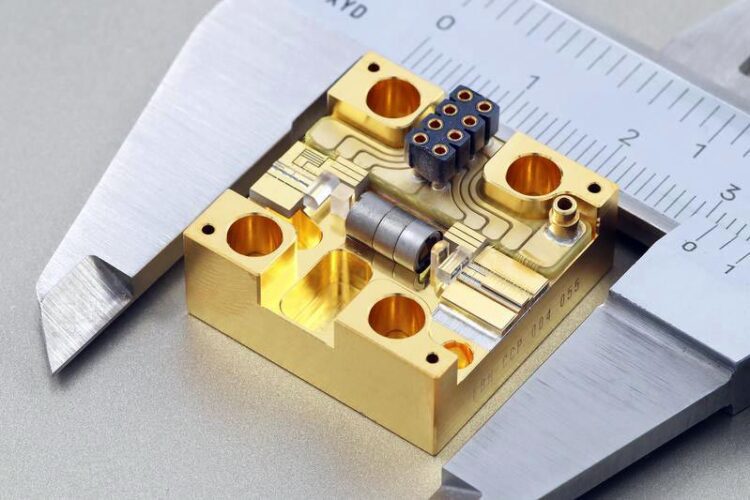Miniaturized pump laser modules

Miniaturized and robust pump laser module for ophthalmology
Credit: FBH/Petra Immerz
… for more cost-effective laser systems in ophthalmology.
Scientists at the Berlin-based Ferdinand-Braun-Institut (FBH) have developed prototypes of miniaturized and robust laser modules for ophthalmology. They can be used as reasonably priced pump sources in laser systems to treat retinal detachments. In addition, their wavelength can be precisely adjusted to the respective application.
Detachment of the retina in the eye can lead to visual impairment and even blindness. Laser coagulation is a well-established method to treat holes or fissures in the retina using laser points. This technique is used to deal with diseases such as diabetic retinopathy and age-related macular degeneration. However, the systems currently utilized are rather expensive and limited to a few laser wavelengths.
This might be changed by semiconductor-based, particularly efficient and reliable laser sources from the Ferdinand-Braun-Institut. They can be flexibly adjusted to the optimal wavelength and realized cost efficiently. Only recently, FBH scientists have developed miniaturized and robust laser sources emitting in the near-infrared (NIR) wavelength range with high spectral radiance and a performance well suited for industrial applications. The sources each consist of a pump laser whose light from the NIR spectral range can then be converted using a nonlinear crystal – this frequency doubling (Second Harmonic Generation – SHG) halves the wavelength. As a result, the laser then emits in the visible spectral range. Current systems for laser coagulation use specifically the wavelengths 532 nm and 577 nm. Therefore, FBH pump modules target these established wavelengths in the yellow-green spectral range. Lasers emitting at 577 nm are particularly interesting for ophthalmology since the oxygen-rich blood pigment, known as oxyhemoglobin, absorbs most strongly at this wavelength.
The unique combination of miniaturized light modules as pump sources followed by highly efficient SHG stages makes it possible to cover the entire spectrum from 400 nm to 600 nm. In contrast, the wavelengths of previous solid-state laser systems are limited to the 532 nm, 561 nm, 577 nm and 586 nm laser lines. Moreover, the laser diodes and amplifiers can be manufactured in large quantities on wafers, thus reducing costs. For example, 400 of these active components fit on a 3-inch wafer with a diameter of 7.6 cm.
The laser source in detail
The spectrally narrowband pump sources at 1154 nm and 1064 nm provide very high optical output powers with an excellent beam quality. Subsequent frequency doubling into the yellow-green spectral range is thus simplified. This reduces cost and weight compared to the more complex laser sources used for laser coagulation to date. Portable, correspondingly flexible use of the systems in an outpatient environment would be possible as well.
To demonstrate the suitability of the light modules as pump sources, FBH scientists have developed module prototypes with separate laser beam generation (Master Oscillator – MO) and power amplification (Power Amplifier – PA). A commercial miniaturized isolator was integrated between the two components to completely protect the laser (MO) from external feedback. This can be very high (> 1%) in SHG crystals with waveguides and can significantly interfere with the MO. Despite the small footprint of only 25 mm x 25 mm, the modules achieve optical output powers of more than 8 watts in continuous wave (CW) mode at 1064 nm as well as 1156 nm. At the same time, they achieve a very good beam quality of M2 < 2 and a spectral linewidth of < 5 MHz. This performance can also be transferred to other wavelengths.
Weitere Informationen:
https://www.fbh-berlin.de/en/transfer-services/modules-systems/life-sciences-mea… Diode Lasers for Life Sciences, Measurements & Displays
Media Contact
All latest news from the category: Medical Engineering
The development of medical equipment, products and technical procedures is characterized by high research and development costs in a variety of fields related to the study of human medicine.
innovations-report provides informative and stimulating reports and articles on topics ranging from imaging processes, cell and tissue techniques, optical techniques, implants, orthopedic aids, clinical and medical office equipment, dialysis systems and x-ray/radiation monitoring devices to endoscopy, ultrasound, surgical techniques, and dental materials.
Newest articles

Sea slugs inspire highly stretchable biomedical sensor
USC Viterbi School of Engineering researcher Hangbo Zhao presents findings on highly stretchable and customizable microneedles for application in fields including neuroscience, tissue engineering, and wearable bioelectronics. The revolution in…

Twisting and binding matter waves with photons in a cavity
Precisely measuring the energy states of individual atoms has been a historical challenge for physicists due to atomic recoil. When an atom interacts with a photon, the atom “recoils” in…

Nanotubes, nanoparticles, and antibodies detect tiny amounts of fentanyl
New sensor is six orders of magnitude more sensitive than the next best thing. A research team at Pitt led by Alexander Star, a chemistry professor in the Kenneth P. Dietrich…





















